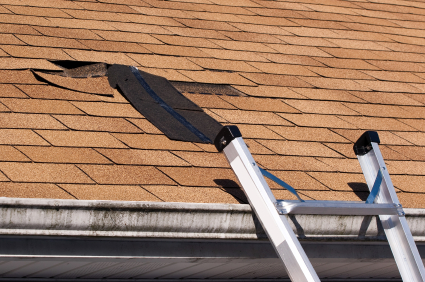Shingles cover the roofing substructure to help sloping roofs shed rain, snow, ice and hail while channeling water away so that standing pools of water will not weaken structural integrity or allow water to seep under shingles and leak from ceilings or down interior walls. Replacing an entire roof offers dangerous risks and exhausting work, but homeowners can replace damaged or missing shingles easily. Check roofs for leaks each fall and spring, replacing any shingles that have become cracked, curled-up, broken or missing in action from severe weather or high winds.

Tools and Materials Needed to Replace Shingles
The right tools help to make roofing repair jobs go smoothly. The first requirement is a sturdy extension ladder, which handy homeowners should never leave unattended while making repairs. A complete list of tools and materials includes the following shingle-laying essentials:
- Extension ladder
- Claw hammer
- Shingle ripper or hacksaw for wood shingles
- Chisel
- Pry bar
- Roofing nails
- Roofing cement
- Utility knife
- Replacement shingles
Shingles come in asphalt, wood, fiberglass, metal and ceramic materials, so determine the type and size of shingles to match roof composition.
Step-by-Step Guide to Shingle Replacement
Replacing one shingle requires loosening the damaged shingle and the shingles on the two rows immediately above it. Use a long knife to cut through cement in the middle of the shingle. The following steps will help homeowners make effective and safe shingle repairs:
- In addition to the cement, properly installed shingles have eight nails—four in the middle and four on the top. Use a pry bar to lift the damaged shingle carefully to loosen nails without damaging the surrounding shingles. Remove the nails.
- Repeat the process on the next level, and then remove pry up the damaged shingle to remove the top nails.
- Remove shingle, and if necessary, use it as a guide to size the replacement, which might need cutting to fit.
- Slide the new shingle into place with a coating of cement in the middle and a dab at each corner, which helps to hold it place.
- Attach four nails at the top and middle of the shingle to affix it permanently. Hammer nails gently in the replacement and surrounding shingles to stabilize the repair.
- Cover the tops of the nails with roofing cement to make the repair watertight. The shingles might need weights overnight to keep them flat.
Roof Shingle Repair Tips
Never risk safety for speed or convenience. If the weather threatens rain, snow, bitter cold or high winds, delay the repair project. Excess heat can also prove problematic if replacing several shingles because roof surfaces heat to extreme temperatures and working on the roof exposes workers to direct sunlight, so take temperatures into consideration and work in the mornings or evenings when it’s hot.
Position the ladder roughly one-fourth of the roof’s height away from the house to create a safe and secure angle for support. The top of the ladder should extend several feet above the roof line. Get someone to watch the ladder when ascending or descending to prevent mishaps. Other tips include the following advice:
- Make repairs only when roofs are completely dry. Slippery roofs cause falls.
- Rubber-soled or antislip shoes help to limit risks. Stay aware of any overhead power lines, roofing structures and other navigation obstacles.
- If unable to find matching shingles, nonmatching shingles will work, especially aluminum or copper.
- Always use safety ropes and secure ladders with proper anchoring techniques.
- Using a utility knife to round the back corners of replacement shingles makes it easier to slide them in place.
- Improper installations and defective flashings around chimneys account for over 90 percent of all roof leaks, so inspect flashings when checking for damaged shingles.
- Multiple leaks, significant damage or installing ceramic tiles might need the expertise of professional roofers. If repairs fail to control leaking ceilings, then hire a licensed roofer.
When to Replace Roofs
Roofs with severe damage need professional attention because several complications develop. Housing codes allow stacking up to three layers of shingles, but after reaching the limit, homeowners must remove old shingles, which presents the challenges of removing old tiles and disposing of them. Laying an entire roof involves flashing problems, waterproofing, dealing with uneven surfaces, following overlapping patterns to channel water off the roof and getting the necessary building permits.
Homeowners and landlords might want to consider replacing roofs with more than 20-percent damage to protect their property from the devastating effects of leaks. Timely repairs help to limit deterioration and reduce the need for costly repairs and replacements. Following safety guidelines and planning repair jobs could save lots of headaches, and getting a friend to help offers protection from many kinds of emergencies that might occur.
Tags: repair, roof replacement, roofing, roofing materials, shingles
